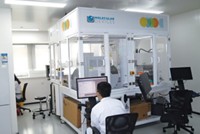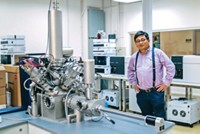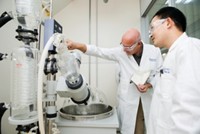Advertisement
Grab your lab coat. Let's get started
Welcome!
Welcome!
Create an account below to get 6 C&EN articles per month, receive newsletters and more - all free.
It seems this is your first time logging in online. Please enter the following information to continue.
As an ACS member you automatically get access to this site. All we need is few more details to create your reading experience.
Not you? Sign in with a different account.
Not you? Sign in with a different account.
ERROR 1
ERROR 1
ERROR 2
ERROR 2
ERROR 2
ERROR 2
ERROR 2
Password and Confirm password must match.
If you have an ACS member number, please enter it here so we can link this account to your membership. (optional)
ERROR 2
ACS values your privacy. By submitting your information, you are gaining access to C&EN and subscribing to our weekly newsletter. We use the information you provide to make your reading experience better, and we will never sell your data to third party members.
Pharmaceuticals
Developing Drugs For Chinese Patients
A growing number of companies are researching and developing pharmaceuticals tailor-made for Chinese patients
by Jean-François Tremblay
June 11, 2012
| A version of this story appeared in
Volume 90, Issue 24

In less than 30 years, China has vaulted out of its isolation to become an economic superpower. But in the area of health care, the country’s performance has not been as stellar. China’s life sciences sector remains far less innovative and sophisticated than life sciences in Western countries and Japan. As a result, despite its growing material affluence, China is poorly equipped to meet the unique medical needs of its population.
A number of companies are out to change this landscape. Privately funded start-ups, multinational firms, and local generic drug producers are turning their attention to the specific requirements of Chinese patients. Given China’s growing affluence, for-profit outfits anticipate healthy financial returns from researching and developing drugs that address Chinese needs.
Those needs are huge and growing rapidly. China has the world’s largest number of diabetics—90 million Chinese have type 2 diabetes, more than the numbers in the U.S. and India combined. Chinese citizens are increasingly falling ill with cancer. And, executives at companies conducting R&D in China tell C&EN, about 130 million Chinese, or 10% of the country’s population, carry the hepatitis B virus. Left untreated, hepatitis B can deteriorate into liver cancer.
Most of the diseases found in China are also prevalent in Western countries that have developed adequate treatments for them. However, some diseases that are commonplace in China are relatively rare in the West and Japan—and therefore not thoroughly studied and understood. Other diseases, such as diabetes, are common in both China and the U.S., but Chinese patients do not respond favorably to Western treatment.
“Hepatitis B is more prevalent in China than in the West, as are lung cancer, intestinal cancer, and stomach cancer,” says Yuguang Wang, senior vice president of discovery chemistry services at Shanghai ChemPartner, a pharmaceutical contract research organization.
Environmental factors may also be involved, Wang adds. For example, more people work in mines in China, and the air in cities tends to be more polluted than in Western countries. Pesticides may have contaminated drinking water sources in the Chinese countryside to a degree that would be rare in a Western society with more years of affluence under its belt. And Chinese people are more likely to fall prey to complications from drinking liquor because they often lack the enzymes for processing alcohol.
Hygiene is another environmental factor involved in disease in China. Many Chinese live in, work in, or are routinely exposed to unhygienic conditions, according to Wei Zheng, director of Chengdu-based Haisco Pharmaceutical Group. Whereas people in other countries usually contract hepatitis B through contact with an infected person, it’s lack of good sanitation that is typically to blame in China, he says.
Haisco, a generic drug producer, launched a research and development program this year through which it hopes to develop a treatment for hepatitis B that would be priced far lower than the options offered by large multinational firms. Because Chinese patients’ incomes are generally lower than those of their Western counterparts, one of Chinese patients’ needs is cheaper drugs.
Diabetes is not well understood in China. At Eli Lilly & Co.’s new R&D center in Shanghai, center head Bei Zhang says that, unlike in the West, diabetes is not commonly associated with obesity in China. “A diagnosis of diabetes is identical in China and in the West, but beyond that, we observe differences in metabolism in patients,” she says.
Initially employing 150 scientists, the Lilly center will focus on studying diabetes in China. The Indianapolis-based drugmaker has conducted pharmaceutical R&D in China for many years, but it has done so through research contractors such as ChemPartner, where it indirectly employs several hundred scientists.
It would not be unusual for Lilly or another drug company to come up with a treatment aimed specifically at Chinese patients, says David E. Moller, Lilly’s vice president for endocrine and cardiovascular research and clinical investigation. In past clinical trials conducted by Lilly, he notes, patients from particular ethnic groups failed to respond or responded differently to certain drugs than did patients from other groups. Some drugs currently marketed in the U.S. carry ethnicity-specific prescription guidelines, Moller adds. One such example is BiDil, a heart drug for African Americans.

Whether it makes commercial sense to research and develop drugs specifically for China comes down to specific circumstances. The country may be the world’s third-largest drug market, after the U.S. and Japan, but it is a distant third. According to the consulting firm IMS Health, China’s drug market was worth $41 billion in 2010, compared with $308 billion for the U.S. that year.
“The potential return on investment in drug research depends on how long it takes to develop a drug, how much it costs, how big the market is, and the probability of success,” points out Jimmy Wei, venture partner at the China affiliate of U.S. private equity firm Kleiner Perkins Caufield & Byers. KPCB’s first priority is to invest in companies that have a good chance to get a drug approved in the U.S. and internationally. But there can be compelling commercial reasons to back a company that is planning strictly Chinese launches, Wei says.
Developing a drug in China can be done more quickly than in a Western country, Wei explains. Although obtaining approvals from regulators takes longer, the clinical trials can be conducted much faster. On the whole, the difference can add up to several years. And the risk of failure is probably lower in China because regulators are willing to approve drugs that aren’t particularly superior to products already on the market. In part, he says, a lower price helps to clear a drug for approval.
For example, Wei says the Chinese company BetaPharma obtained Chinese regulators’ clearance to launch a lung cancer drug that is in the same class as Tarceva, a drug that was codeveloped by OSI Pharmaceuticals and Roche. “BetaPharma probably would not have gotten approval in the U.S. because of the similarity, but they’re selling it for a lot less than Tarceva,” he says.
Several of the companies that are researching and developing drugs in China focus on oncology because cancer drugs are quite expensive in China, Wei says. Moreover, because oncology drugs are sold directly to hospitals, a company that develops one doesn’t need a large sales team.
One company that is focused on oncology research is Hangzhou-based Ascletis. The company raised $100 million from a local investor last year and obtained a $1.6 million grant from the Hangzhou government. It now operates out of temporary lab space where it employs 30 people. It broke ground last October on a complex that will house its labs, manufacturing facilities, and sales team.
It may seem strange that a start-up would already be building its own manufacturing facility. But in China, says Jinzi J. Wu, Ascletis’ cofounder and chief executive officer, a company that wants to conduct clinical trials must produce its own drug materials, or at the very least have control over the quality systems at a toll manufacturer. Prior to launching Ascletis, Wu headed a research unit at GlaxoSmithKline in Research Triangle Park, N.C.
Ascletis’ commercial-scale production facility will be ready to operate in three years, he expects, but smaller units producing quantities sufficient for clinical trials will be ready earlier. In addition, if Ascletis needs to start clinical trials before any of its facilities are on-line, the company has negotiated a toll manufacturing agreement with a local producer.
Ascletis focuses on liver, lung, and stomach cancers. To launch drugs in China, it will conduct in-house R&D programs while simultaneously in-licensing compounds that are already in Phase I or II clinical trials from firms in China or abroad. “We will license compounds where, in some cases, there are no data indicating whether or not the compound is effective in Chinese patients, and we will generate that data,” Wu says.
Ascletis’ own research will start with drug targets that have already been validated by other scientists. “We look at the existing compound classes, and our chemists come up with a compound that is different enough to obtain Chinese regulatory approval,” says Emil W. Fu, Ascletis’ vice president of research.
If the disease being pursued is prevalent mainly in China, the commercial space that uses the same target will not be crowded, and Ascletis scientists should be able to come up with a compound that is both effective and different, Fu says. “There aren’t many people in the West who are engaged in researching diseases that are mostly specific to China.”
In Chengdu, leaders of the generic drug manufacturer Haisco are hopeful that they can learn to become innovators while meeting China’s need for cheaper drugs. The firm is in the process of hiring 80 people to staff its new drug R&D lab. They will work in the same building as the 250 scientists who develop the company’s generic drugs. They will be led by Peng Cho Tang, who earlier in his career managed 35 medicinal chemists at South San Francisco-based Sugen, which is now part of Pfizer.
Lower prices rather than higher effectiveness is part of Haisco’s development strategy. “The Chinese government will approve our hepatitis B drug even if it’s not better, or is only slightly better, than what is already on the market,” says Wei Zheng, the company’s director. At the moment, he says, the only patented hepatitis B treatments available in China are from Western companies, and their prices are too high for most Chinese patients to afford. Haisco will not infringe on any patent, he stresses.

Haisco will initially be in a learning mode when it comes to drug R&D, Zheng admits. But its knowledge of China’s regulatory process will work in its favor during trials. The focus of the company’s generics business is to be the first to launch a generic version of a drug that has lost patent protection. In China, unlike in the U.S., the first generic version of a previously patented drug goes through a complex approval process that includes full clinical trials, Zheng says.
In contrast to Haisco, which expects to rapidly launch drugs that differ only slightly from existing ones, Lilly’s new Shanghai lab will conduct fundamental research aimed at understanding diabetes in Chinese patients, says Zhang, who heads the U.S. company’s new lab. She insists that the focus will not be on minor modifications for China of drugs that Lilly already launched elsewhere. “We need to better understand the disease pathology and the genetics,” she says.
Much is still not understood. For example, it’s not completely clear whether an ethnically Chinese diabetic born in the U.S. should get the same treatment as that of a Caucasian American or that of a Chinese person living in China, Zhang says. What’s more, whereas type 2 diabetes and obesity go hand in hand in the West, that’s not always the case in China. Research needs to be performed to better understand how diabetes develops in Chinese patients, whose diets typically include more vegetables than those of residents of Western countries, Zhang says.
As it ramps up the Shanghai lab, Lilly will enjoy an improving research environment in the city. Development of an innovative drug industry has become a national priority for China, and the government is investing in the necessary infrastructure, particularly in Shanghai.
In the Zhangjiang Hi-Tech Park, where the Lilly lab is located, the National Center for Drug Screening has just finished constructing a new building to house the 700,000 compounds in its inventory. Most of the compounds in the library, 500,000 or so, were donated by Novo Nordisk. The government-funded center conducts its own research program and performs work on behalf of companies.
One of the center’s main functions is to support the development of pharmaceutical R&D in China, according to Xin Xie, a biologist and the center’s deputy director. When working on behalf of private companies, her group prepares assays with which compounds can be tested for specific biological activity. Her own research is on the role of G protein-coupled receptors in autoimmune diseases.
Advertisement
Today, private-sector drug R&D in China is 20 years behind the U.S., Xie estimates. “The Chinese government wants companies to do breakthrough discovery work,” but most local companies are capable of developing only comparable or slightly better drugs, she says. “Most cannot perform any target identification work.”
China may not yet be on the cutting edge of drug research, but for Chinese patients in need of better or cheaper treatments for their unique ailments, the strides that the country’s scientists have made are welcome nonetheless.





Join the conversation
Contact the reporter
Submit a Letter to the Editor for publication
Engage with us on Twitter